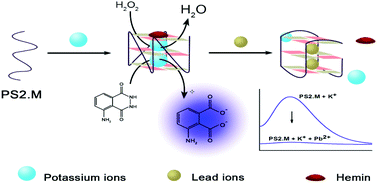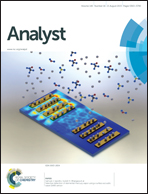Highly sensitive chemiluminescent detection of lead ion based on its displacement of potassium in G-Quadruplex DNAzyme
Abstract
A simple and highly sensitive method for detecting lead ion (Pb2+) in biosamples was developed based on its displacement of potassium in G-Quadruplex DNAzyme, which can catalyze the luminol–H2O2 chemiluminescence (CL) reaction. By introducing a G-rich DNA sequence, PS2.M, which can fold into a G-quadruplex when binding with hemin in the presence of K+ and act as a superior horseradish peroxidase (HRP) mimicking-enzyme, we found this DNAzyme can effectively catalyze the H2O2-mediated oxidation of luminol, resulting in strong CL emission. The K+-stabilized G-quadruplex, upon the addition of Pb2+, is transformed into a Pb2+-stabilized G-quadruplex with higher stability but poor DNAzyme activity, sharply decreasing the CL readout signal. With this, a simple and sensitive detection method for Pb2+ in biosamples such as human hairs was developed with a linear range of 0.4–10 nM Pb2+ and a limit of detection (3σ) of 0.06 nM. Owing to the introduction of G-quadruplex DNAzyme, which was employed not only as a sensing unit but also as a catalyst in the chemiluminescent assay, this method holds great potential for clinical plumbism diagnosis by testing hair.


 Please wait while we load your content...
Please wait while we load your content...